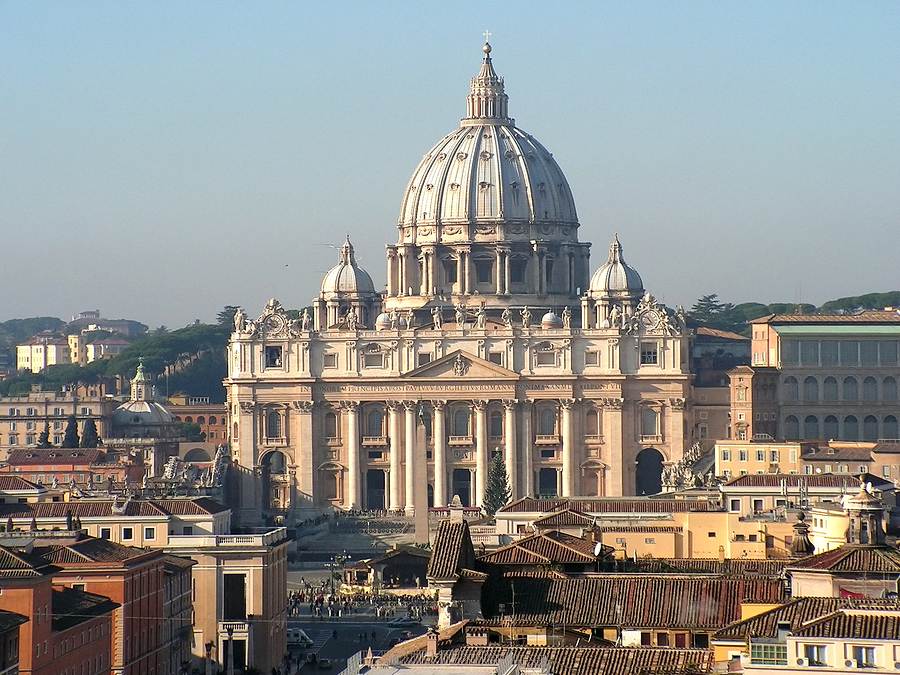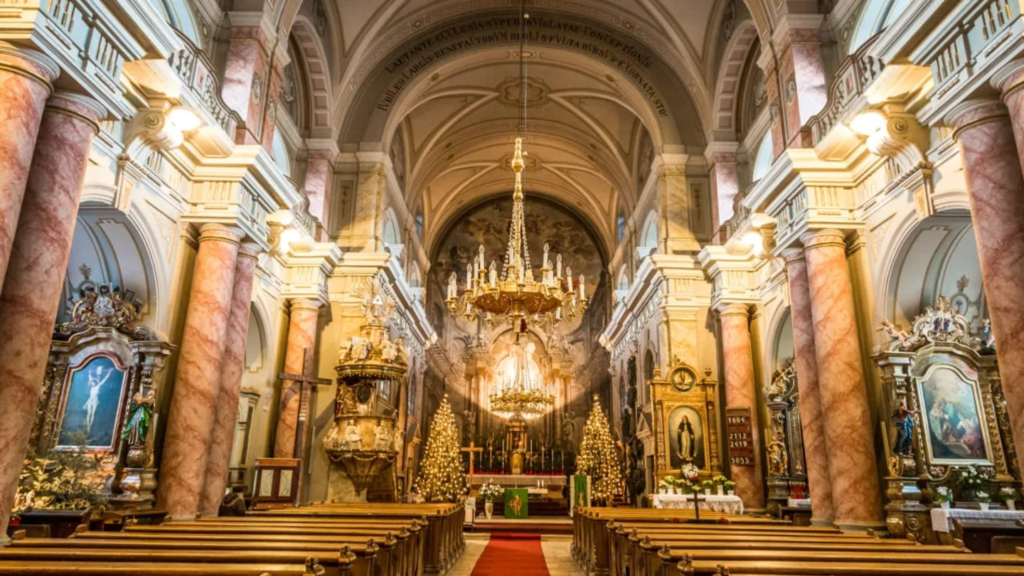For most Christians, even the non-liturgical types, a visit to St. Peter’s Basilica is on their bucket list. I’ve had the pleasure of visiting it myself, and richly enjoyed my time there. Not just the building itself, but everything about the experience felt special. It made me realize that not everyone has a full appreciation for the significance of a basilica as compared to other churches. I wanted to learn more about what makes one a basilica, and have compiled this article with what I learned from various sources as well as my own research.
A Basilica is a church building, more prominent than a parish church or cathedral. A basilica differs from a cathedral in being of greater monumental size, instead of encompassing the diocesan bishop’s offices and houses of the chapter, it contains the place where the bishop’s throne is placed, called the cathedra. Like a cathedral it contains the altar however it lacks its own choir and organ unless they are at some point within the church itself. A basilica may have just one nave with side chapels or two (besides the apse) naves and two rows of chapels on either side of the central nave.
In the Catholic Church, major basilicas are churches of “primatial” rank. This means that they have special privileges, such as being the location for a wedding in case no civil venue is available. The title of major basilica was introduced by Pope Urban VIII on February 11, 1625 (formally promulgated October 21). Later, the term came to refer to buildings with a certain set of architectural and pastoral elements, which in 1908 Pope Pius X defined as follows: In England the word basilica was used from approximately the 12th century to denote any church built in a Romanesque style.
Officially designated as Churches of extraordinary solemnity and importance, the basilica represents the place of Christian initiation and the center of a diocese, with active liturgical functions. This article makes it clear and simple what constitutes a basilica.
A basilica is a type of Christian church that has been designated as such by the Pope. There are over 1,700 churches in the world that have been designated as basilicas. These churches are considered to be of major importance for their history and significance.
In order for a church to be designated as a basilica, it must meet certain criteria. The church must have been built as a place of worship, and it must have been constructed before 1700. The building should also have historical or artistic value. The Pope is responsible for naming basilicas throughout the world; he does so after consulting with bishops and cardinals who are knowledgeable about the area where the church is located.
A church is considered a basilica if it has certain features and characteristics. A basilica is any building that has a central plan, with an apse and a long nave with side aisles. These features distinguish it from other types of churches, such as those with cruciform (cross-shaped) plans or churches that are domed.
Basilicas are generally Roman Catholic churches, though they can also be found in Eastern Orthodoxy. The best-known example of a basilica is Saint Peter’s in Rome, which is recognized by both Roman Catholics and Eastern Orthodox Christians as the burial place of Saint Peter, who was one of Jesus’ disciples.
Churchgists will provide you with all the relevant information you are looking for on basilica architecture characteristics, list of basilicas, what is a basilica vs cathedral, and so much more.
What makes a church a basilica
Introduction
The word basilica originally referred to the ancient Roman government building, which was often a courtroom or hall of justice. The basilicas that we visit today as sacred spaces are much different! A church that is considered a basilica may be called so because of its special relationship with the pope, its antiquity, its size and/or architectural beauty, or because it is the papal seat in a particular country.
What is a basilica?
A basilica is a special designation for a church. It can be applied to any one of several churches, each with its own significance. The title is bestowed by the pope as a mark of honor and comes with certain privileges, such as the right to perform marriages and baptisms without requiring permission from another bishop.
Basilicas are the most important churches in the Catholic Church — but this doesn’t mean they’re all cathedrals! Cathedrals are simply large churches that serve as seats for bishops; unlike basilicas, they have no special privileges or rights attached to them (at least not in modern times).
what is a basilica vs cathedral
A basilica is a Catholic church that has been designated as such by the Pope. The designation does not mean that the building is an official residence of a bishop, or even used for religious services. It simply means that it’s an important part of Catholic history and an important place for ceremonies.
Basilicas are usually built in honor of saints or martyrs who have made significant contributions to the church throughout its history. A few examples include St Peter’s Basilica in Rome and Notre Dame de Paris, both built over 1,500 years ago; St Michael’s Basilica in Montréal (Canada), which was completed in 1904; and Saint Patrick’s Cathedral in New York City—which was originally built as Old St Patrick’s Cathedral but demolished after being damaged during 9/11 terrorist attacks before being rebuilt into what we know today as Saint Patrick’s Cathedral—which was completed around 1878.
How many basilicas are there in the US?
There are ten basilica churches in the US: St. Peter’s Basilica, Vatican City; San Francisco Cathedral, San Francisco; Our Lady of Victory Basilica, Los Angeles; St. Mary’s Assumption Church, San Francisco; Mission San Carlos Borromeo de Carmelo (Mission Carmel), Carmel-by-the-Sea and Mission Santa Teresa De Avila (The Alamo), San Antonio; Notre Dame de Namur Basilica (Namur Shrine), Belmont CA; St. Louis Cathedral French Quarter New Orleans LA
Where is the oldest basilica in the US?
St. Mary’s Basilica in Baltimore is the oldest Catholic cathedral in the United States. It was built in 1790 and its design was based on St. Peter’s Basilica in Rome. The building was designed by Benjamin Henry Latrobe, who also designed the Capitol Building in Washington D.C., as well as many other buildings throughout Virginia and Maryland during his time in America (1796-1820).
The church has been modified over time to accommodate changing liturgical needs and styles, but it still retains much of its original appearance from when it first opened its doors for worship in 1806.
The first Mass celebrated at St Mary’s Cathedral was held on July 4th, 1806 by Bishop Carroll (first bishop of Baltimore). During that same year, Father Francis Neale built what would become one of America’s greatest pipe organs—a masterpiece with 3 manuals containing two thousand pipes made by Edmund Schiedmayer (Wurzburg) and Jacob Graff (Frankfurt am Main) between 1803-1805).

list of basilicas
West Europe
Andorra Andorra 1
Austria Austria 36
Belgium Belgium 30
England England 4
France France 174
Germany Germany 78
Iceland Iceland 1
Ireland Ireland 2
Italy Italy 584
Luxembourg Luxembourg 1
Malta Malta 12
Netherlands Netherlands 28
Portugal Portugal 14
San Marino San Marino 1
Spain Spain 129
Switzerland Switzerland 12
Vatican City State Vatican City State 1
East Europe
Belarus Belarus 3
Croatia Croatia 8
Czechia Czechia 15
Greece Greece 1
Hungary Hungary 16
Latvia Latvia 1
Lithuania Lithuania 8
Montenegro Montenegro 1
Poland Poland 156
Romania Romania 4
Russia Russia 1
Serbia Serbia 2
Slovakia Slovakia 15
Slovenia Slovenia 7
Ukraine Ukraine 4
North America
Canada Canada 27
Mexico Mexico 33
USA USA 90
Central America
Costa Rica Costa Rica 2
Cuba Cuba 5
Dominican Republic Dominican Republic 2
El Salvador El Salvador 4
Guadeloupe Guadeloupe 1
Guatemala Guatemala 2
Honduras Honduras 1
Nicaragua Nicaragua 3
Panama Panama 3
Puerto Rico Puerto Rico 2
Saint Lucia Saint Lucia 1
South America
Argentina Argentina 49
Bolivia Bolivia 9
Brazil Brazil 78
Chile Chile 9
Colombia Colombia 39
Curaçao Curaçao 1
Ecuador Ecuador 12
Paraguay Paraguay 2
Peru Peru 13
Suriname Suriname 1
Trinidad and Tobago Trinidad and Tobago 1
Uruguay Uruguay 6
Venezuela Venezuela 16
South and East Asia
China China 1
India India 28
Japan Japan 1
Malaysia Malaysia 1
Philippines Philippines 19
Sri Lanka Sri Lanka 1
Taiwan Taiwan 2
Vietnam Vietnam 4
Central and Southwest Asia
Israel Israel 4
Kazakhstan Kazakhstan 1
Palestine Palestine 5
Turkiye Turkiye 2
Oceania
Australia Australia 5
Guam Guam 1
Samoa Samoa 1
Tonga Tonga 1
Western and Northern Africa
Algeria Algeria 2
Benin Benin 1
Burkina Faso Burkina Faso 1
Cote d’Ivoire Cote d’Ivoire 1
Egypt Egypt 2
Ghana Ghana 4
Nigeria Nigeria 1
Senegal Senegal 1
Tunisia Tunisia 1
Eastern and Central Africa
Cameroon Cameroon 1
Congo-Kinshasa Congo-Kinshasa 1
Equatorial Guinea Equatorial Guinea 2
Kenya Kenya 1
Rwanda Rwanda 1
Uganda Uganda 3
Southern Africa
Zimbabwe Zimbabwe 1
Is St. Patrick’s Cathedral a basilica?
While you may have heard that St. Patrick’s Cathedral is a basilica, it is not. If you’re looking for an official title for the cathedral, its proper designation is “cathedral.” The term basilica can be used to describe both churches and cathedrals, but there are some distinct differences between the two.
St. Patrick’s Cathedral was constructed as a cathedral in 1878 to serve the Archdiocese of New York (the seat of which is located at St. Patrick’s). As such, it is still considered both the mother church and principal church of that archdiocese today; however, being an archdiocese itself constitutes its ecclesiastical rank above what would otherwise be called a mere “cathedral.” In short: while it may look like a basilica on paper (and therefore give rise to confusion), St. Patrick’s Cathedral remains just another beautiful example of late Gothic revival architecture that happens to be home base for several million Catholics worldwide—but no more or less holy than any other historic house of worship built within living memory.

There are 4 types of churches that can be called basilicas, and only one of them is papal.
There are four types of churches that can be called basilicas, and only one of them is papal. The other three are cathedral, co-cathedral, and minor basilica.
- Cathedral Basilica: A cathedral is a church with the rank of bishop’s seat or patriarchate. It is the principal church where the bishop or archbishop has his cathedra (seat). An example is St. Peter’s Basilica in Rome; St. John Lateran has been a cathedral since its construction in 313 AD but was not made a bazilika until 1587 by Pope Sixtus V because it was on imperial land during Constantin era when Christianity was illegal (the Ottomans conquered Constantinople). Since then it has been known as “St John Lateran Basilica” or “San Giovanni Battista al Laterano”. If a building has both functions (cathedral and basilica) then it can’t be used at all times for both purposes; if you want to attend mass there during liturgy time you’ll have to wait outside until Mass ends! This also means that while its doors remain open 24/7 every day so do theirs…
Conclusion
Now you know more about basilicas! If you’re interested in learning about other types of churches, check out our blog post on how many different kinds of churches there are. Or if you want to know some fun facts about Catholicism and the world’s largest church, St. Peter’s Basilica, we have that too! All this information might come in handy if someone ever asks why their church isn’t a basilica – now they’ll know all the reasons why they can’t be one too!